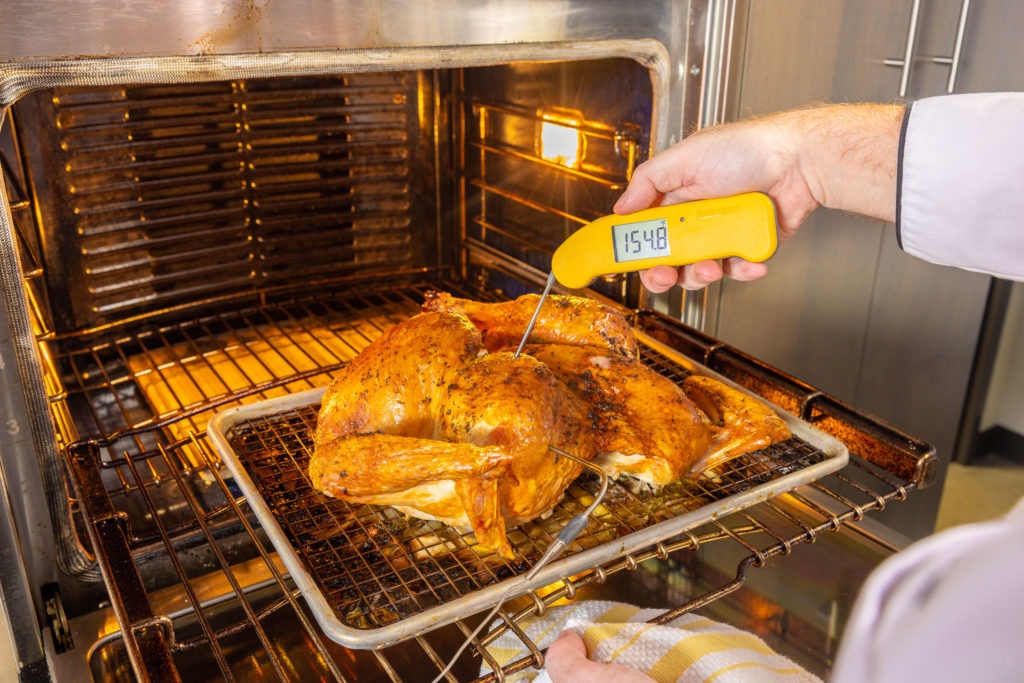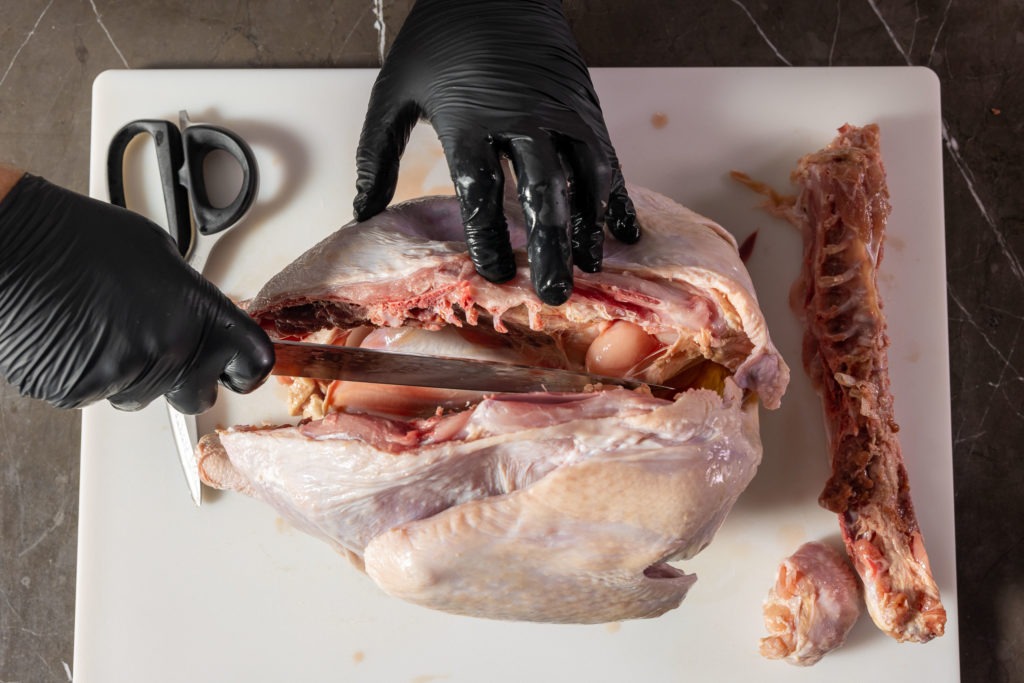Thanksgiving Day’s highlight dish is the golden, juicy turkey. But it can also be problematic. It takes up space in the oven, for one thing. Apart from the fact that it is frequently overcooked and half of the skin—which we want to be extremely crisp—is soaked and squidgy at the bottom of the bird, doesn’t that bird know you have sweet potatoes, rolls, and green bean casserole waiting in line? However, laying the bird flat while roasting is a simple yet incredibly effective time-saving tip. Continue reading if you’re the kind of person who prefers the unconventional and thinks outside the box. This fast-roasting turkey method is for you.
Though its etymology is unclear and up for debate, most agree that the word “spatchcock” originated in Scottish or Irish usage. Whatever the term’s origin, it means “butterflying” when used to refer to whole fowl. In essence, we flatten the bird by removing the backbone and arranging the legs and wings around the breast, like rays shining out from a white-meat sun. We’ll go into more detail about the precise procedure below. By doing this, the surface area is greatly increased and greatly improved over the semi-spherical shape it originally occupied.
We hear you asking, “But what about Grandfather bringing the perfect turkey to the table to carve it?,” and we guess that’s a legitimate question, but we would also like to remind people that Norman Rockwell was most known for his paintings rather than his cooking. We’re not the only ones who don’t think that cooking something just because it looks good is always the best option!
Forget the traditional image of a plump, whole-roasted turkey as the centerpiece of your Thanksgiving feast A new contender has emerged, promising faster cooking times, crispier skin, and juicier meat: the spatchcocked turkey
But what is spatchcocking, and is it truly the superior method for preparing your Thanksgiving bird? Let’s delve into the reasons why spatchcocking might just revolutionize your holiday tradition
5 Reasons to Consider Spatchcocking Your Turkey:
-
Faster Cooking: Spatchcocking dramatically reduces cooking time, potentially cutting it in half compared to roasting a whole turkey. This means less time spent in the kitchen and more time enjoying the company of loved ones.
-
Crispy Skin and Juicy Meat: The flat, spatchcocked turkey allows for even heat distribution and exposes more skin to direct heat, resulting in a beautifully browned and crispy exterior. Meanwhile, the exposed meat cooks quickly and retains its moisture, ensuring a succulent and flavorful bird.
-
Tastier Gravy and Stuffing: Roasting your spatchcocked turkey over a bed of vegetables and herbs adds extra flavor to the drippings, creating a more delicious base for your gravy. Additionally the faster cooking time prevents the vegetables from overcooking resulting in a more flavorful and satisfying stuffing.
-
Simplified Presentation: Carving a whole turkey can be a daunting task, but a spatchcocked turkey is much easier to handle. You can carve it before presenting it, eliminating the need for table-side carving and ensuring everyone gets a perfectly portioned piece of juicy meat.
-
Versatility: Spatchcocking isn’t limited to roasting. You can also smoke or grill your spatchcocked turkey, adding even more flavor and variety to your Thanksgiving feast.
Concerns and Considerations:
While spatchcocking offers numerous advantages, there are a few considerations to keep in mind:
- Butchering Skills: Spatchcocking requires removing the backbone of the turkey, which may intimidate some cooks. However, with a good pair of poultry shears and a bit of practice, it’s a manageable task.
- Stuffing Dilemma: Traditional stuffing, cooked inside the cavity of the bird, isn’t possible with a spatchcocked turkey. However, you can easily prepare a delicious stuffing separately and bake it alongside the turkey.
- Presentation: While a spatchcocked turkey is easier to carve, it may not have the same visual impact as a whole roasted bird. However, with some creative plating and garnishes, you can still create a stunning centerpiece for your Thanksgiving table.
Spatchcocking offers a faster, more flavorful, and more versatile way to prepare your Thanksgiving turkey. While it requires a slight shift from tradition, the benefits are undeniable. If you’re looking to elevate your Thanksgiving feast with a juicy, crispy, and beautifully browned bird, spatchcocking is definitely worth considering.
Spatchcocked turkey roasting temp
Once your bird is well flattened, it’s time to roast. Cook your bird until the internal temperature on your ChefAlarm® reaches 155°F (68°C) at 425°F (218°C). (If that doesn’t seem low, check out our piece on chicken internal temperatures; the ideas are the same for both chicken and turkey.) We promise that a turkey cooked to that temperature will be much more juicy than one cooked to a higher temperature. Make sure there are no lower temperatures by using your Thermapen® ONE to confirm that temperature. If not, you’re probably done cooking—you’ll have spent roughly 90 minutes cooking a 16-pound turkey. Wow!.

We hope you give this unorthodox turkey a try. It is superior in every manner and will give you a turkey that people will like to eat rather than just act interested in. If you follow our suggested temperatures and don’t forget the aromatics, you will undoubtedly win Thanksgiving royalty.

Preferred by people who know
Mark Bittman of the NY Times, and the author of How to Cook Everything, once put together a minimalist Thanksgiving dinner to cut down on prep, cook time, and ingredients so he could have time and energy to actually enjoy the meal with family and friends. This method was part of it. Bittman’s first spatchcocking video made its appearance in 2008. Since then a number of celebrity chefs have also applied the same method, with spatchcocking becoming an official foodie trend by 2012.
Kenji Lopez-Alt is another chef who swears by a flat bird! His discussion about and recipe for a spatchcocked turkey and many others can be found in his book, The Food Lab.
Expert after expert, chef after chef—those in the know favor the Spatchcock technique
- It Saves Time: Mark splits and flattens the turkey to reduce the amount of time needed to roast it. The turkey flattens out, increasing its exposed surface area and decreasing its overall thickness to a nearly uniform level. By using this preparation, you can accelerate the cooking process by blasting the turkey at a higher oven temperature. Depending on the size of the bird, complete cooking could be completed in as little as 45 minutes. Spatchcocking tackles the problems of oven space as well as time. You’ll still have space in the oven for pies, rolls, and other baked goods after the turkey has been flattened.
- Turkeys with flat shapes have trouble cooking evenly because they are almost spherical in shape. When a turkey is spatchcocked, its legs are much more exposed than when it is in its natural shape. This is fantastic because the temperature of the dark meat in the breast must be higher than that of the light meat.
- Crispier Skin and Juicier Meat: When a bird is spatchcocked, its entire skin is exposed and facing up. This will produce a turkey with skin that is perfectly crisp and evenly browned throughout. The juices that come out of the skin keep the meat nice and moist.
- Improved Gravy: By taking out the backbone, you have an additional way to flavor your gravy. Use the neck, giblets, and backbone to quickly make a stock, and then combine it with the turkey drippings to make your gravy. There’s no need to make the gravy with store-bought chicken stock. (Not that your bird will require gravy—you won’t But you will need some for your potatoes. ).
- The Drippings: Oh, the drippings! Arrange carrots, celery, onion, parsnip, turnip, green apple, herbs, and lemon in the bottom of your sheet tray. As your bird cooks, its juices and butter—oh, the butter—dribble down into a hot pan full of flavorful goodness rather than the bird’s own cavity. The vegetables simmer and sauté in the juices to create the most delicious pan sauce ever. No need for thickener, no need for gravy. You won’t want to cook your bird any other way once you dip the meat in it and use it to scoop up the veggies.
Disadvantages:
We’ve covered all of the benefits of this technique, so what are the disadvantages? The most frequent criticism of spatchcocking is that it “just doesn’t look right.” We already proved that we don’t need to cling to that misplaced sense of nostalgia, though. The process’s anatomical component is the only significant disadvantage. It could be deemed … unpleasant. For the squeamish. But once you give it a shot, it’s actually pretty satisfying.
Enough talk about why spatchcocking is so great. You just need a chef’s knife, poultry shears, and a cutting board. It’s much simpler than you might think! It’s easy as long as you don’t find the sound of breaking bones repulsive.
Follow These Easy Steps:
- Lay the turkey, backbone side up, on a chopping board after patting it dry.
- Using poultry shears, make cuts on both sides of the backbone, beginning at the bottom and working your way up to the neck. Use a knife to cut through any material that the shears are unable to cut through. You have now removed the backbone. Set aside to use when making your gravy.
- Make one incision on each side of the breastbone or down the middle of it. Turn the turkey breast side up.

- Using your palms, flatten the bird and break its breastbone (ribs will break as well). Perhaps you should use a stool to gain more leverage.

- Move the legs out to the side and tuck the wings under. Trim the excess neck skin. Your bird is now spatchcocked and ready to go.

Spatchcocked Turkey | Better. Faster. Juicier.
Is a Spatchcock Turkey better than a whole turkey?
While Classic Roast Turkey looks the most Norman Rockwell-esque on a platter, spatchcocking turkey has serious advantages over whole roast turkey. More Surface Area for Crispy Skin. Since the bird is laid flat, all of the skin is on the top, where it’s more directly exposed to heat, giving you more golden, crispy skin.
Should you Spatchcock a Turkey?
Say goodbye to eating dry turkey meat. One of the biggest benefits of spatchcocking your turkey is that it keeps the meat moist while providing you with crispy skin. According to López-Alt, this has to do with how the flattened turkey sits in the pan—all of the skin faces upward in open air, while the exposed meat is on the bottom.
What is Spatchcocking a Turkey?
Spatchcocking is a cooking technique that refers to butterflying a bird to prepare it for cooking. Essentially, you are removing the backbone so it can lie flat on the pan. With more of the turkey’s surface area exposed, the bird will cook faster and more evenly.
Does a spatchcocked Turkey have a backbone?
Since the skin of a spatchcocked bird is all on top, it all crisps up beautifully, giving you more crispy skin than a conventionally cooked bird. The removed backbone can be used to give your gravy an extra dimension of turkey flavor.
